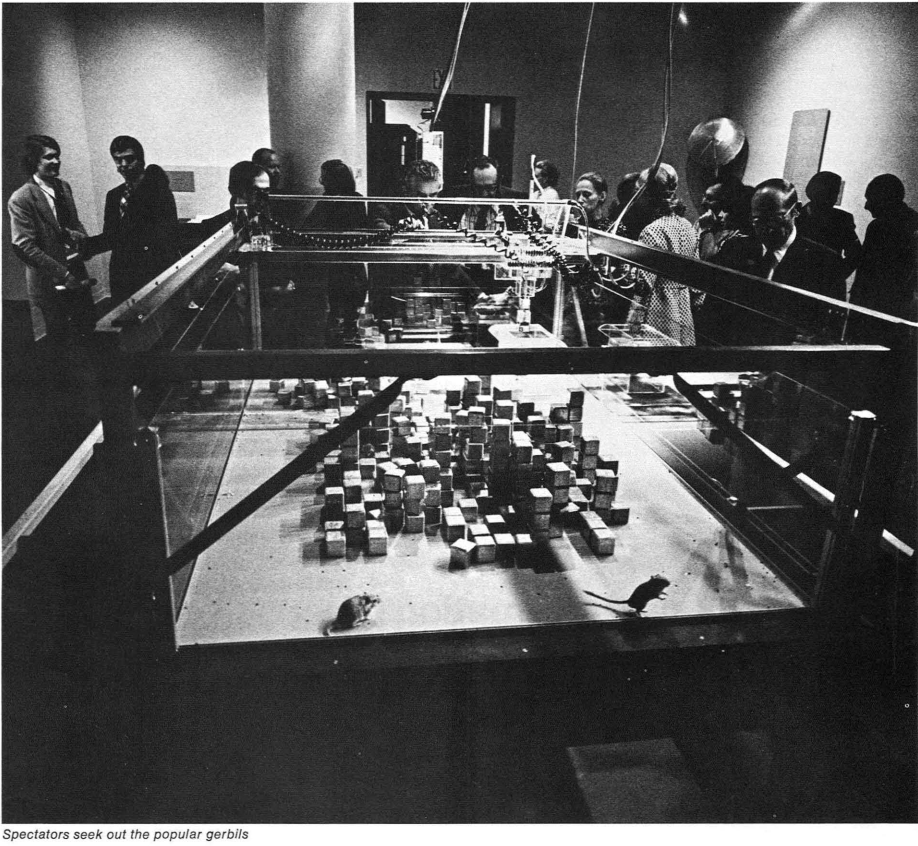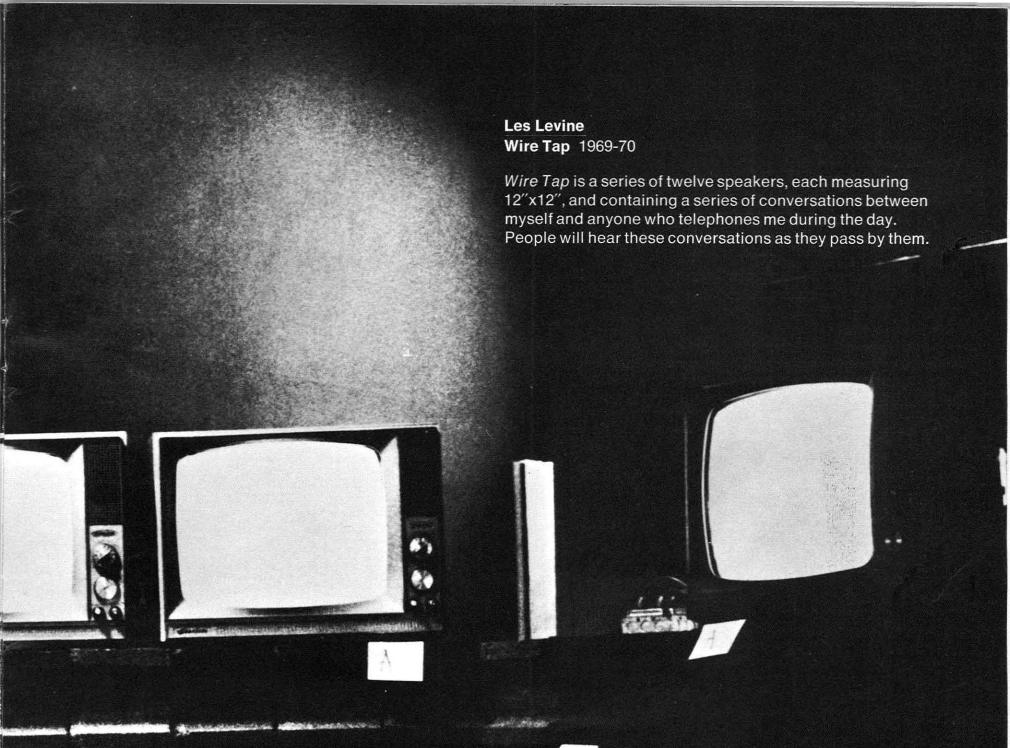created 2025-03-17, & modified, =this.modified
tags:y2025artcomputerscomputational-aesthetics
rel: Prehistoric Digital Poetry - C.T. Funkhouser The Machine as Seen at the End of the Mechanical Age, catalog 1969
Note
The show put together computers and conceptual artists, linking them through the idea of software as a process or a program to be carried out by a machine or, why not, by the audience based on “instruction lines” formulated by the artist.
I was reading about this in Prehistoric Digital Poetry - C.T. Funkhouser and found the exhibition book

Software is an exhibition which utilizes sophisticated communications technology, but concentrates on the interaction between people and their electronic and electromechanical surroundings. This is the same exploration, in human factors, which we use in the engineering design of our automobiles as a human environment. This exhibition encourages artists to use the medium of electronic technology in challenging and unconventional ways. The link between art and science, which the artists in Software are examining, is the same link we must explore and strengthen in our automotive styling and engineering. Because of our continuing interest in people, in technological achievement, and in the advancement of modern art forms, our involvement in Software has been both rewarding and stimulating.

In such forms information processing technology influences our notions about creativity, perception, and the limits of art. Thus it may not be, and probably is not, the province of computers and other telecommunication devices to produce art as we know it; but they will, in fact, be instrumental in redefining the entire area of esthetic awareness.
Minsky on Software and Hardware
Minsky concludes that we build machines in our own self-image-although such a separation between body and mind may be no more than an illusion fostered by our lack of scientific knowledge about human biology and communication systems in general.
Software is the part of a system which is more easily changeable.
NOTE
This is true in the sense that I can uninstall, and replace software. It will be necessarily upgraded. But I’ve also encountered entrenched legacy software systems, or evolutions of software which have outlasted their conceiving hardware by years.
It can also be thought of as the degree which you can pull away from Photoshop as a base of users, versus deciding on a new Mac or Windows PC.
In the way this catalog frames software as goals and behaviors of equipment, it seems more enduring.
 One purpose of this exhibition is to “undermine the normal perceptual expectations and habits which viewers bring to an art exhibition. In some cases it is done by deliberately separating or isolating communication structures from their usual surroundings.”
One purpose of this exhibition is to “undermine the normal perceptual expectations and habits which viewers bring to an art exhibition. In some cases it is done by deliberately separating or isolating communication structures from their usual surroundings.”
All information becomes obsolete unless it remains in a meaningful context to us.
NOTE
Hmm. To find some obsolete concept, like some virus buried in permafrost, who contextually finds host and is all that can be said, ever again.
The writers observe that information is always defined by a point of view, whether a favored theory, an available technology, or a social condition.
In The Gutenberg Galaxy McLuhan defines machines of the nineteenth century, the effects of mass production, and the technology of the printed book as “homogeneous segmentation” , or the proliferation of experience through duplication. This, according to McLuhan, is “the method of the fixed or specialist point of view that insists on repetition as the criterion of truth and practicality.” For example, it is safe to say that the popularity and efficacy of modern art is to a large degree the result of good, cheap color reproductions produced by the millions. The magic of personal creativity in the Machine Age was, and to some degree still is, the recreation of the individual’ s gesture through the anonymous, all-pervasive means of the mass media. So, increasingly the importance of the work of art is seemingly in direct proportion to the number of times it is reproduced for popular consumption. Literacy, in McLuhan ‘s judgment, produces a closed circuit of values, one that makes the distinction between art and non-art not only possible but necessary. In mythic terms, works of art are singular or unique; but paradoxically we reinforce this uniqueness through mass production of the art object’s image. The non-literate tradition produced myths and ta les which could be told over and over again in an infinite number of ways; with the coming of the book, their counterpart was the idea of the masterpiece.
As demonstrated in Ted Nelson’s essay on “cybercrud” , we seem to be the victims of a perpetual consumer’s fraud, no matter how promising the hardware and software.
Computer programming can be the most varied and creative activity that one can do on salary, allowing the most initiative and variety of personal means of expression.
The Crafting of Media by Ted Nelson
The all-purpose machine, as von Neumann called it, has been falsely promulgated to the public as the so called computer, numerical, uncompromising, demanding and intractable.
Words - Hypercrud: I would like to employ the word cybercrud to mean, in general, putting things over on people using computers. Cybercrud is one of the most important specialties, if not the economic backbone, of the computer field. The promotion of false or clumsy approaches to a problem as ” scientific,” the frequent claim that “the computer has to have it that way” - when a certain thing could be programmed very differently - are cybercrud.
Amazing:
As we learn to free ourselves from cybercrud, the question becomes not, ” how do I relate to this sinister, demanding artifact?” but “what is the grooviest way to use this thing?”
Until now, our media-letters, books, television-have been based on specific inventions and technical connections. But no longer are specific inventions of special importance: information may be commuted to any form ,functioning networks may be built connecting any device to any other device; total trans-pluggabil ity has come. (Imagine if you will a device with a red oval 2-inch TV screen, a set of chimes in the natural key of C, a smell generator cap able of giving off most smells, and a foghorn. Should the F.C.C. authorize this combination as a broadcast medium?)
The new age will not be “scientific.” The word” scientific” is obsolete (except where specifying the activities and problems of scientists), like the adjectives “modern” and “streamlined.” The technological imperative is a fake, computerization can take whatever form we wish it to; therefore we must learn about computers in order to wish better. As Burnham says at the end: “...Software makes none of the usual qualitative distinctions between the artistic and technical subcultures. At a time when esthetic insight must become a part of technological decision-making, would such divisions make sense?”
Ted and Ned Woodman present Labyrinth a hypertext, or interactive retrieval system.
To read in this interactive catalogue, the user sits down at one of many Labyrinth keyscope terminals and begins to read. To read more of any section which is larger than the screen, the user types F (forward). To go back to the beginning of the catalogue, the user types R (return). To obtain a related section as indicated by an asterisk appearing in the text, the user types the code appearing with the asterisk.

Seek by The Architecture Machine Group M.I.T
Seek is a sensing/effecting device controlled by a small general purpose computer. In contrast to an input/output peripheral, Seek is a mechanism that senses the physical environment, affects that environment, and in turn attempts to handle local unexpected events within the environment. Seek deals with toy blocks which it can stack, align and sort. At the same time, these blocks form the built environment for a small colony of gerbils which live within Seek’s three-dimensional world.
Unbeknownst to Seek, the little animals are bumping into blocks, disrupting constructions, and toppling towers. The result is a substantial mismatch between the three dimensional reality and the computed remembrances which reside in the memory of Seek ‘s computer. Seek’s role is to deal with these inconsistencies.
via closed-worlds “OUTSMARTING MACHINE: The gerbils began to outsmart the machine by climbing on the robotic arm.”
If computers are to be our friends they must understand our metaphors. If they are to be responsive to changing, unpredictable, context-dependent human needs, they will need an artificial intelligence that can cope with complex contingencies in a sophisticated manner (drawing upon these metaphors) much as Seek deals with elementary uncertainties in a simple-minded fashion.
Hans Haacke News
Local, national and international news is being received from U.S. as well as from foreign news services. It arrives in the exhibition via teletype print-out at the same time as it is being received by the other clients of the various news ser vices. The print-out accumulates and piles up behind the teletype machines.
Linda Berris Tactile Film

This is the first motion picture created to be felt as well as seen and heard. It is des igned to be played back through the Vision Substitution System, which converts light images into tactile dotted images. Use of the System to transmit speciall y designed motion pictures is a new application for th is System-one which is not part of the basi c laboratory resea rch. Work on the present film began over a year ago when Linda Berris conducted independent explorations to find out what kinds of images and movements could be most successfully conveyed through the System. The film reflects her findings in this personal project. The film is both an explanation and a work of art. Poetic images are used to suggest scientific concepts related to touch and other senses and to demonstrate some of the possibilities of the System. The sense of touch is the primary co nsideration in the organization of the film and in the des ign of each image. Simple abstract forms- such as lines, circles. and squares-convey the meaning of the film in universal symbols. (To identify more complex shapes, participants would need hours of training with the System.)
The Boolean Image/Conceptual Typewriter
We are surrounded by a causal reality, bordered by our concepts of birth and death. Inside this reality we stabilize ourselves by making decisions. The Boolean Image is a matrix built upon this supposition . It is a womb containing decisional cues. These cues are neutral elements placed into specific relationships with each other. On the se elements we hang decisions, labels which make them into anything we decide them to be. Since such decisional cues often occur in relational groupings or sets the matrix was named after George Boole, the originator of set theory.
NOTE
I struggled to understand this piece, and it is the one which kicked off my awareness of this event.
The Conceptual Typewriter may be thought of as the instrument created when the ” Conceptual Typewriter” program is loaded into the IDIIOM. Ten illuminated buttons on the control button-box represent ten con cepts suggested by the I Ching . The view er may add concepts or replace them with the buttons, or alter them with the light-pen
Wire Tap

